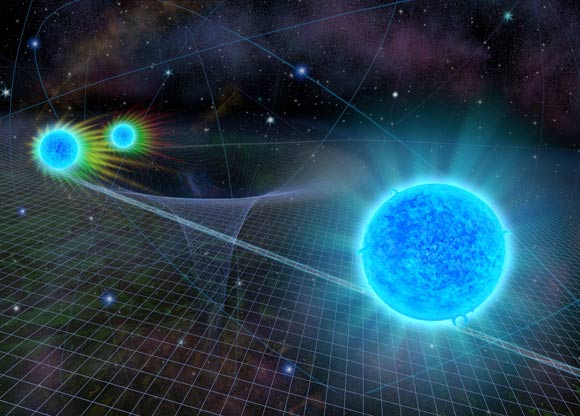In a test of Einstein’s theory of general relativity near the supermassive black hole at the center of our Milky Way Galaxy, an international group of astrophysicists has demonstrated that the theory holds up.

A star known as S0-2 made its closest approach to Sagittarius A*, the a supermassive black hole at the center of the Milky Way, in 2018. Image credit: Nicolle Fuller / National Science Foundation.
Albert Einstein’s theory of general relativity predicts that a star passing close to a supermassive black hole should exhibit an effect known as relativistic redshift.
The new research involved detecting relativistic redshift in the light emitted by a star closely orbiting Sagittarius A*, the supermassive black hole at the center of the Milky Way.
“Einstein’s 1915 theory of general relativity holds that what we perceive as the force of gravity arises from the curvature of space and time. Einstein proposed that objects such as the Sun and the Earth change this geometry. The theory is the best description of how gravity works,” said University of California, Los Angeles Professor Andrea Ghez, co-author of the study.
Professor Ghez and colleagues analyzed observations of a star called S0-2 as it made its closest approach to Sagittarius A* in 2018.
The star moves around the black hole at blistering speeds of more than 16 million mph (25.7 million kmh).
The team also used spectroscopic and astrometric measurements from 1995-2017, which cover S0-2’s 16-year orbit.
“What’s so special about S0-2 is we have its complete orbit in three dimensions. That’s what gives us the entry ticket into the tests of general relativity,” Professor Ghez said.
“We asked how gravity behaves near a supermassive black hole and whether Einstein’s theory is telling us the full story. Seeing stars go through their complete orbit provides the first opportunity to test fundamental physics using the motions of these stars.”
The team’s results are consistent with general relativity and substantially favor the theory over Newtonian gravity, which cannot account for the observed redshift.
“Einstein’s right, at least for now. We can absolutely rule out Newton’s law of gravity,” Professor Ghez said.
“Our observations are consistent with Einstein’s theory of general relativity. However, his theory is definitely showing vulnerability. It cannot fully explain gravity inside a black hole, and at some point we will need to move beyond Einstein’s theory to a more comprehensive theory of gravity that explains what a black hole is.”
The findings were published in the journal Science.
_____
Tuan Do et al. Relativistic redshift of the star S0-2 orbiting the Galactic center supermassive black hole. Science, in press; doi: 10.1126/science.aav8137







